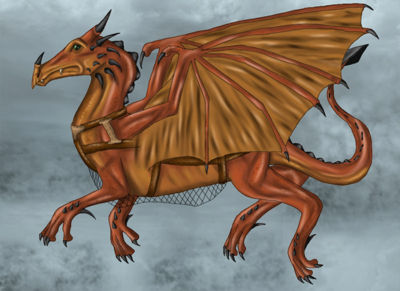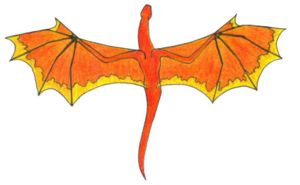Difference between revisions of "Regal Copper"
(→Species Notes) |
Laurelhach (talk | contribs) |
||
| Line 10: | Line 10: | ||
According to Sir [[Edward Howe]], Regal Coppers were descended from the Spanish [[Cauchador Real]] mixed with the smaller British breed known as [[Bright Copper]]s. It was a successful breeding experiment, as Regal Coppers were both larger than their ancestors and better able to sustain flight over distance. They are not prolific, with only four or five Regal Coppers born in a generation. | According to Sir [[Edward Howe]], Regal Coppers were descended from the Spanish [[Cauchador Real]] mixed with the smaller British breed known as [[Bright Copper]]s. It was a successful breeding experiment, as Regal Coppers were both larger than their ancestors and better able to sustain flight over distance. They are not prolific, with only four or five Regal Coppers born in a generation. | ||
| − | Mature Regal Coppers weighed as much as 50 tons and were as long as 120 feet; the British believed them to be the largest breed of dragon. Their colouring was dramatic, shading from red to yellow, with variety between individual dragons. Female Regal Coppers tended to be slightly larger than males. Mature males developed forehead horns, and both sexes had a spiny column along the back, which made matters difficult for enemy boarding parties. All | + | Mature Regal Coppers weighed as much as 50 tons and were as long as 120 feet; the British believed them to be the largest breed of dragon. Their colouring was dramatic, shading from red to yellow, with variety between individual dragons. Female Regal Coppers tended to be slightly larger than males. Mature males developed forehead horns, and both sexes had a spiny column along the back, which made matters difficult for enemy boarding parties. All Regal Coppers are badly farsighted, so they must be rather far away from an object in order to see it clearly. |
| − | Regal Coppers were among Britain's most valuable dragons at the start of the 19th Century. When [[Temeraire]]'s egg was captured from the French the Imperial and Celestial breeds were known only to European scholars and no previous determination of their worth had been made. In terms of prize money Temeraire's egg was valued as equal to a Regal Copper (55000 pounds), a mark of the importance of both breeds. | + | Regal Coppers were among Britain's most valuable dragons at the start of the 19th Century. When [[Temeraire]]'s egg was captured from the French, the Imperial and Celestial, both rare Chinese breeds, were known only to European scholars and no previous determination of their worth had been made. In terms of prize money Temeraire's egg was valued as equal to a Regal Copper (55000 pounds), a mark of the importance of both breeds. |
It was considered dangerous to keep two male Regal Coppers together, or they would fight. Dragons are generally reluctant to fight smaller dragons. Since Regal Coppers were both rare and very large, a male Regal Copper would rarely have the chance to meet another dragon his own size and therefore worth picking a fight with. | It was considered dangerous to keep two male Regal Coppers together, or they would fight. Dragons are generally reluctant to fight smaller dragons. Since Regal Coppers were both rare and very large, a male Regal Copper would rarely have the chance to meet another dragon his own size and therefore worth picking a fight with. | ||
Revision as of 14:22, 21 September 2008
Dragon Breed Data
| Breed Name: | Regal Copper |
| National Loyalty: | Britain |
| Physical Characteristics: | Very large; red to yellow coloring |
| Special Abilities: | |
| Known Members: | Maximus |
Species Notes
According to Sir Edward Howe, Regal Coppers were descended from the Spanish Cauchador Real mixed with the smaller British breed known as Bright Coppers. It was a successful breeding experiment, as Regal Coppers were both larger than their ancestors and better able to sustain flight over distance. They are not prolific, with only four or five Regal Coppers born in a generation.
Mature Regal Coppers weighed as much as 50 tons and were as long as 120 feet; the British believed them to be the largest breed of dragon. Their colouring was dramatic, shading from red to yellow, with variety between individual dragons. Female Regal Coppers tended to be slightly larger than males. Mature males developed forehead horns, and both sexes had a spiny column along the back, which made matters difficult for enemy boarding parties. All Regal Coppers are badly farsighted, so they must be rather far away from an object in order to see it clearly.
Regal Coppers were among Britain's most valuable dragons at the start of the 19th Century. When Temeraire's egg was captured from the French, the Imperial and Celestial, both rare Chinese breeds, were known only to European scholars and no previous determination of their worth had been made. In terms of prize money Temeraire's egg was valued as equal to a Regal Copper (55000 pounds), a mark of the importance of both breeds.
It was considered dangerous to keep two male Regal Coppers together, or they would fight. Dragons are generally reluctant to fight smaller dragons. Since Regal Coppers were both rare and very large, a male Regal Copper would rarely have the chance to meet another dragon his own size and therefore worth picking a fight with.

